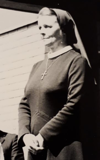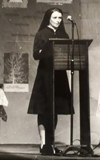Education for All: The Life and Work of Sister Colette Dwyer

The Life and Work of Sister Colette Dwyer
In 1967, standing in a field that was home to nine traveller families, a Holy Child sister stopped and asked a simple question: “is there anything I can do for you?”. When a woman asked to be taught to read, a skill most take for granted, Sister Colette Dwyer invited the group to the convent at Killiney to see what could be done.[1] This month’s article looks at Colette’s life and ministry as an SHCJ, a testament to the remarkable change that one person – with the support of friends like the steadfast Sister Cyprian Unsworth – can make to society.
Colette was professed 83 years ago, on 22nd April 1938. She was also born this month, on 17th April 1917 in Cork to Walter Dwyer and his third wife Marie Goldie. Although christened Marie Therese, her family knew her as Rosemary. Her name in religion was taken in memory of her sister Colette, who died at the age of 11.[2] Her early ‘carefree’ years were spent near the banks of the River Lee but the arrival of the Black and Tans in Cork meant the family had to move to Blarney. Rosemary’s happy existence continued with her brother Dermot and sisters Maureen and Colette, until the death of her father.
Right: Sr Colette Dwyer at the Opening of Sallynoggin Community School in 1971.
Rosemary’s mother then married a cruel and violent man. Maureen ran away from home in the early days, but Marie Goldie still endured 18 years of ill-treatment before leaving her abusive husband. This traumatic experience gave Rosemary an understanding of and empathy for children from unhappy and abusive homes which she used throughout her varied ministries.[3]
Rosemary’s introduction to the Society of the Holy Child Jesus came about due to her mother’s belief that the seaside location of St Leonards-on-Sea would be good for Rosemary’s health. While spending a ‘glorious’ year in Rome, Rosemary began to develop a religious vocation that caused her so much unease she became ‘as difficult a student as possible so the nuns would not have her!’. Rosemary still saw through her vocation, initially teaching French at St Leonards, evacuating to Torquay with the children during the Second World war.
After completing an English degree at Oxford, Colette taught in a secondary modern as part of her training with University College London. She enjoyed encouraging less able children in the schools’ E stream. Despite expressing a desire to continue such work, Colette was posted as a teacher and headteacher in independent schools for the first 32 years of her ministry in education. She soon learned that even children from affluent backgrounds would suffer the effects of broken homes and long absences of parents.[4]
[1] Colette Dwyer, Cyprian Unsworth et al. “Would You Ever Teach us to read, Sister?”, 1995, pp.21 – 22.
[2] Necrology for Sr Colette Dwyer, SHCJ European Province Archives, EP/400/3/Dwyer Marie Therese Rosemary
[3] Colette Dwyer, Cyprian Unsworth et al., 1995, pp.1-3.
[4] Colette Dwyer, Cyprian Unsworth et al.,1995, pp.10-12

She began teaching at Combe Bank in 1945 and became headmistress there. Colette was aware of some of the difficulties of a large boarding school and the children’s need for mutual support. As a remedy, she introduced a ‘families’ system, so that pupils of different ages could socialise, elder girls caring for the younger girls. During her time as headmistress of Mayfield, Colette established the House system. The School Council was also introduced which gave pupils real responsibility and involvement in Mayfield’s management.[5]
Left: Colette speaking at the opening of Sallynoggin Community School in 1971.
When she became superior of Killiney Convent in 1967, Sr Colette began to reflect on Cornelia Connelly’s original vision for the SHCJ, to teach ‘all classes of Society’. On a walk to nearby Sallynoggin, Colette found that there was only one fee paying school serving the area. Here, Cornelia’s original desire could be realised. Colette made contact with educational authorities and worked to establish Sallynoggin Community School. Through the collaboration of Colette as school manager, the lay principal, and other staff alongside two SHCJ nuns, Sallynoggin soon became a ‘real Holy Child School’.[6]
The fateful meeting of Colette and the Traveller families in 1967, led to regular classes being given to adults and teenagers. The teenagers not only continued to attend but brought younger brothers and sisters. A day school was needed but finding a building for it was ‘a hard and discouraging experience’. The prospect of a school for traveller children was met with a reaction of ‘deep hostility’.
[4] Colette Dwyer, Cyprian Unsworth et al.,1995, pp.10-12
[5] ‘St Leonards- Mayfield 1953- 1963’, Mayfield Centenary 1863 – 1963 Booklet.
[6 Sr Colette Dwyer, Sr Cyprian Unsworth et al., pp. 15 -19.

When the initial search had been unsuccessful, Miss Shelia Pim, a committee member, offered two rooms in her own house for the school to use. The following year two prefab buildings were offered by the Marianist Brothers and the number of children increased from 14 to 70. With the help of sponsorship, a site was secured at Old Connaught in 1971, but a series of fundraising efforts was required to keep the school running.
Left: two children aged 10 and 8, introduced to art at St Kieran’s, won prizes out of 5000 children in an art competition held in 1972.
With further publicity and support the school continued to develop. Local teenagers from the settled community, including girls from Holy Child Killiney school, took part in events such as sponsored walks. Killiney girls also organised a dance and invited girls their age from St Kieran’s evening classes. One St Kieran’s girl gave the poignant comment ‘for once we were treated as if we really mattered’. [7] The school was blessed by Archbishop of Dublin, Dr McQuaid – a continuous supporter of Colette, her work and St Kieran’s – in 1972.

Colette’s work with the Travellers went beyond the establishment of St Kieran’s as did the connection of the SHCJ with the Traveller community. In the 1980s, Sisters Helena Brennan, Mary McManus and Mary Taylor lived on a site for travellers in Clondalkin and set up a training centre for girls on the site teaching English, Maths, Religion and practical subjects. Colette became the National Co-ordinator for the Education of Travellers.
Left: Sister Colette and Sister Cyprian meeting Pope John Paul II in 1979.
Supporting Colette since she came to live and work with her in 1975, was Sister Cyprian. A fellow novice with Colette back in the 1930s, Cyprian (known as Cippy by friends and pupils), worked at Sallynoggin and supported all aspects of Colette’s endeavours including acting as secretary for associations of teachers and trainers.[8] Colette described how Cippy championed, consoled and encouraged her ‘to keep trying’. With such a ‘wonderful companion’, the setbacks, opposition and threats faced by Colette were overcome.[9]
In 1973, Colette started a county by county survey of the education and training of Travellers. The spirit of Colette’s work can be seen in questions she posed in the first report she wrote:
What do they want? What do they need? […] Have we consulted them enough? Taken the trouble to get to know their real needs and aspirations?
Colette’s initial investigations in 1973 to 1874 found that only 1, 980 traveller children were enrolled in schools and only about 50% attended regularly.[10] By the 1990s, Colette’s target for over 90% of all Traveller children to attend primary school was reached.[11]
New, permanent buildings for St Kieran’s were opened on 26th September 1990. Reflecting on the school’s growth in the annual report, Colette states that she had first only hoped for the school to last 10 years, but after 22 years the pupils of the early days chose to bring their children there. In keeping with the SHCJ spirit of valuing the individuality of all, Colette saw the school continue to be ‘full of happy children learning to be proud of themselves and their traveller heritage’[12]
[7] St Kieran’s School Annual Report, 1971.
[8] SHCJ EP Archives EP/200/IRL/5/1, ‘Society of the Holy Child Jesus: Involvement of the Society with Travellers’, circa 1984,p.1.
[9] Sr Colette Dwyer, Sr Cyprian Unsworth et al., p. 58.
[10] Colette Dwyer, The Education, Training and Employment of Travellers – 21 Years on: 1988 Report of the National Co-ordinator for the Education of Travellers’, 1988, p.2.
[11] Sr Colette Dwyer, Sr Cyprian Unsworth et al, 1995, p. 28.
[12] St Kieran’s School Annual Report, 1990.
